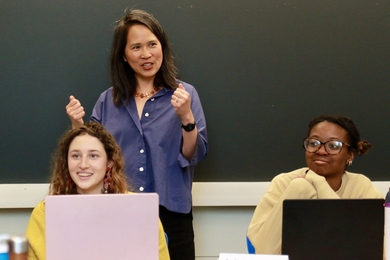Dr. John A. Armstrong, who for several years headed research efforts for IBM as vice president for science and technology, has been appointed the Karl Taylor Compton Lecturer for 1993-94.
Dr. Armstrong, who retired from IBM earlier this year after a 30-year career with the world's largest manufacturer of computers, is internationally recognized as an expert in nonlinear optics, the statistical properties of laser light, picosecond pulse measurements and the multiphoton laser spectroscopy of atoms.
The appointment was announced by Provost Mark S. Wrighton, who said the Compton Lecturer would deliver a series of lectures on topics of Dr. Armstrong's choice during the next academic year. Professor Wrighton said that Dr. Armstrong will have strong interactions with several departments in both the School of Science and the School of Engineering, including the Department of Physics and the Department of Electrical Engineering and Computer Science. He also will be involved in discussions of the research and education enterprise that links universities, industry and the government.
The lectureship, established in 1957, honors the late Karl Taylor Compton, who was president of MIT from 1930-1948, and chairman of the MIT Corporation from 1948-1954. The purpose of the lectureship is to give the MIT community direct contact with the important ideas of our times as propounded by those who have contributed much to modern thought.
Over the years a wide variety of people, including many scientists and several government leaders, have been Compton Lecturers. The first was the Nobel laureate in physics, the late Dr. Niels Bohr, in 1957. The list includes the late Hubert H. Humphrey, who was vice president of the United States and a senator (1969); Linus Pauling, Nobel Laureate in chemistry (1978); and Yasuhiro Nakasone, former prime minister of Japan (1989).
Dr. Armstrong holds the AB in physics from Harvard College (1956) and the PhD (1961) from Harvard University for research in nuclear magnetic resonance at high pressures.
He joined IBM in 1963 as a research staff member. In 1976 he became director of physical sciences for the company and was responsible for a major part of IBM research in physics, chemistry and materials science. In 1980 he was appointed to the IBM Corporate Technical Committee. A year later he was made manager of materials and technology development at the IBM East Fishkill, N.Y., development laboratory, working on advanced bipolar technology and associated packaging. In 1983 he was named vice president, logic and memory, in the Research Division. In 1986 he became director of research and the following year was elected IBM vice president and director of research. In 1989 he was elected a member of the Corporate Management Board and named vice president, science and technology.
Dr. Armstrong is a fellow of the Optical Society of America, the American Physical Society, the American Association for the Advancement of Science, the American Academy of Arts and Sciences and the Institute of Electrical and Electronic Engineers.
He is a member of the National Academy of Engineering and a foreign member of the Royal Swedish Academy of Engineering Sciences. In 1989 he was awarded the George E. Pake Prize of the American Physical Society.
A version of this article appeared in the May 12, 1993 issue of MIT Tech Talk (Volume 37, Number 32).





